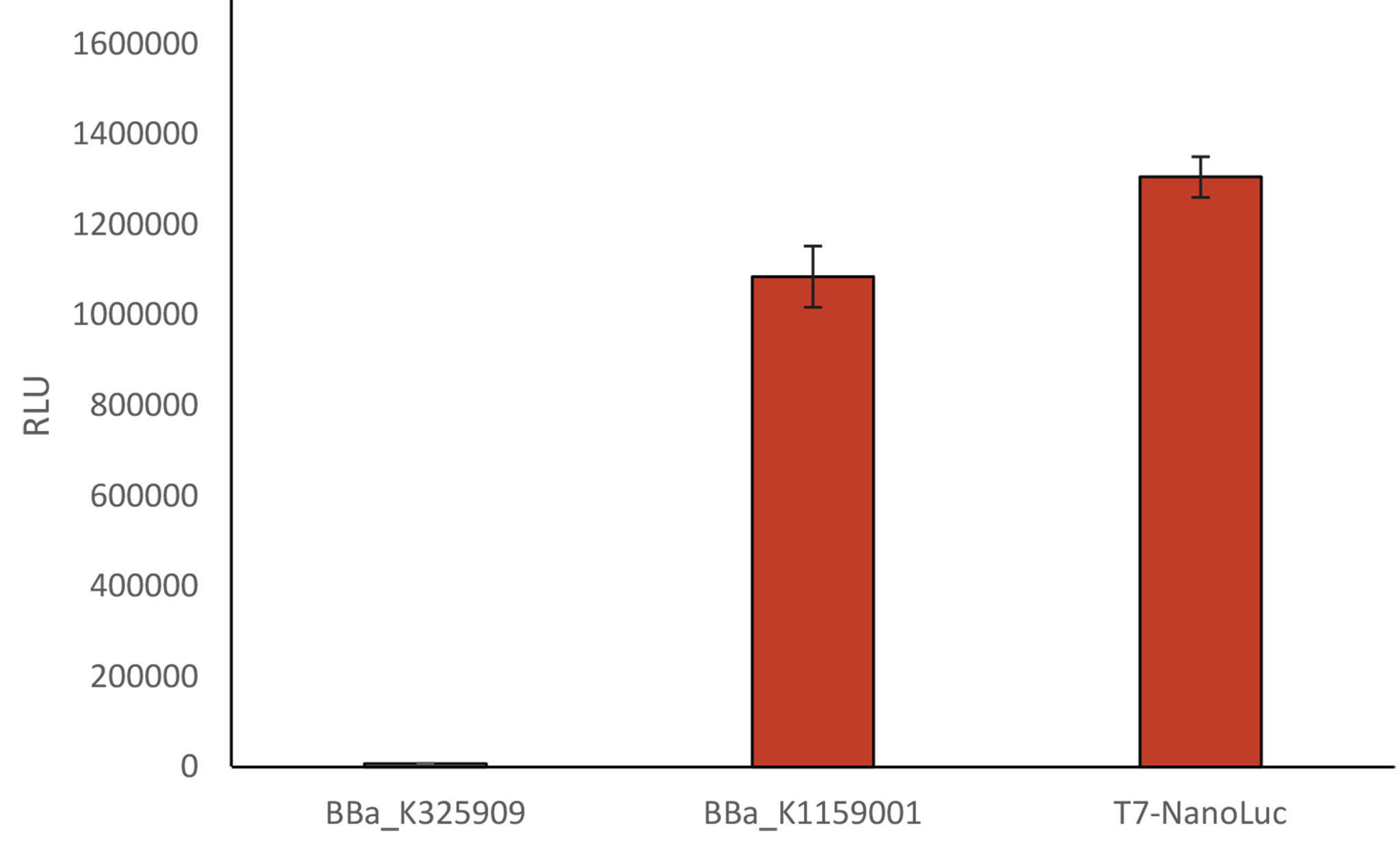Difference between revisions of "Part:BBa K1616023:Experience"
(→Applications of BBa_K1616023) |
(→Applications of BBa_K1616023) |
||
| Line 9: | Line 9: | ||
<br> | <br> | ||
We worked in BL21(DE3) bacteria for our plasmid “T7 Nanoluc”. Thus, addition of IPTG activates the induction of the Plac promoter and then expression of T7 RNA polymerase is possible. It results in different light intensities proportional to the concentration of IPTG: the more IPTG you have, the brighter! | We worked in BL21(DE3) bacteria for our plasmid “T7 Nanoluc”. Thus, addition of IPTG activates the induction of the Plac promoter and then expression of T7 RNA polymerase is possible. It results in different light intensities proportional to the concentration of IPTG: the more IPTG you have, the brighter! | ||
| − | [[Image: | + | [[Image:Nanoluc characterization barchart 2 copie.png|center|500px|thumb|'''Fig. 2:''' Comparison of the relative light unit using 3 differents Biobricks:Induction of BBa_K325909 and BBa_K1159001 with a solution of arabinose 1%, and a solution of IPTG 1 mM for T7-Nanoluc.]] |
<br> | <br> | ||
We compared our new T7 Nanoluc to the first Luxbrick created by Cambridge in 2010 (BBa_K325909), and to BBa_K1159001. T7 NanoLuc showed a 1,2 times brighter light intensity (RLU) than BBa_K1159001 and a light intensity approximately 140 times brighter than BBa_K325909. | We compared our new T7 Nanoluc to the first Luxbrick created by Cambridge in 2010 (BBa_K325909), and to BBa_K1159001. T7 NanoLuc showed a 1,2 times brighter light intensity (RLU) than BBa_K1159001 and a light intensity approximately 140 times brighter than BBa_K325909. | ||
Revision as of 00:36, 24 September 2015
Applications of BBa_K1616023
Liquid culture of bacteria transformed with on BBa_K325909, BBa_K115900 and BBa_K1616023 96 wells plates
Competent cells have been transformed and selected on agar plates containing chloramphenicol. Then, 96 wells plates have been inoculated with colonies to perform liquid culture.
Protein production has been induced when OD600 values were located between 0.6 and 0.8 with inducer such as arabinose or IPTG depanding of genetic constructions and a diminution of the temperature from 37°C to 30°C. After 5 hours of incubation, 50 µl of NanoGlow substrate (Promega) have been added to bacterial culture and light emissions have been measured during the following 120 minutes (excepted for bacteria transformed with BBa_K325909 for which light emissions have been measured during all the experiment). For all colonies the maximal value has been saved.
We worked in BL21(DE3) bacteria for our plasmid “T7 Nanoluc”. Thus, addition of IPTG activates the induction of the Plac promoter and then expression of T7 RNA polymerase is possible. It results in different light intensities proportional to the concentration of IPTG: the more IPTG you have, the brighter!
We compared our new T7 Nanoluc to the first Luxbrick created by Cambridge in 2010 (BBa_K325909), and to BBa_K1159001. T7 NanoLuc showed a 1,2 times brighter light intensity (RLU) than BBa_K1159001 and a light intensity approximately 140 times brighter than BBa_K325909.
User Reviews
UNIQ966b4148e7a50d37-partinfo-00000004-QINU UNIQ966b4148e7a50d37-partinfo-00000005-QINU


